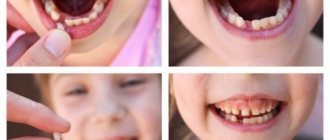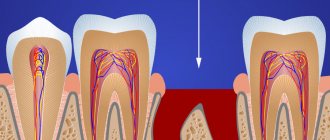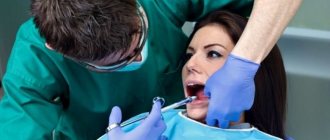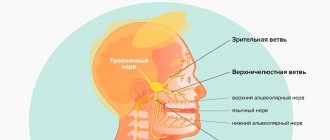The main advantages of dental treatment under anesthesia are that all manipulations can be performed in one visit, and the person will not experience stress. Indeed, due to the lack of emotional reaction of the patient and reduced salivation under general anesthesia, the doctor can carry out treatment to a much greater extent than using local anesthesia. But the fact is that some dental problems cannot be cured in one visit due to objective reasons. In what cases is general anesthesia in dentistry advisable and what risks may occur?
General anesthesia in dentistry
If you don’t delve too deeply into medical terminology, then anesthesia (this term already means general anesthesia of the body, so saying “general anesthesia” is incorrect) is, in fact, an artificially induced reversible condition in which a person is unconscious and has no reaction. for pain. Depending on the type and depth of anesthesia, it can be with spontaneous breathing or with artificial ventilation. The second option requires tracheal intubation (a special tube is inserted into the airway, usually after the patient falls asleep) or the use of other methods that allow air to be blown into the lungs, for example, a laryngeal mask. In dentistry, in the vast majority of cases, spontaneous breathing anesthesia is used.
General anesthesia in dentistry has several stages, which are important for us to consider in order to understand how deep it can be when performing dental treatment under anesthesia.
Analgesia
The analgesia stage begins a few minutes after the drug is administered to the body. With medication, consciousness is switched off, speech becomes incoherent, drowsiness appears, and pain sensitivity is lost. At the same time, breathing, pulse and pressure change little.
Excitation
The stage is characterized by motor and speech restlessness. Reflex activity and muscle tone are increased, the pupils are dilated and respond well to light, breathing is irregular. At this stage, no manipulations are carried out; it is only a transitional moment for immersion in deeper sleep.
Surgical stage
It begins from the moment the excitation ceases and rhythmic breathing is established without visible pauses. The surgical stage is divided into four more types of depth of anesthesia: superficial, light, complete and ultra-deep. With superficial or light general anesthesia, implantation, sinus lifting, treatment, and tooth extraction under anesthesia are performed. Serious maxillofacial operations are performed in deep cases.
Thus, for each type of dental treatment, depending on the degree of trauma and duration, a certain stage and depth of anesthesia is required.
Is it possible to treat teeth without anesthesia?
The stereotype of dental treatment as an inevitably painful procedure is firmly rooted in the public consciousness. That’s why many people are horrified by the sight of a drill. Indeed, previous designs of this technique made the process of filling teeth, if not painful, then, in any case, extremely unpleasant. The mere sound of a working drill created a very unpleasant psychological effect.
Modern dental technology provides virtually painless dental treatment. Today, patient discomfort is minimized. A person feels noticeable pain during dental procedures only if inflammation has developed in his tooth. In this case, pain relief is necessary, despite the danger of side effects of the drug.
Dental treatment without anesthesia has been a common procedure for many centuries.
Therefore, the best way to avoid anesthesia and the negative phenomena associated with it is to treat caries in a timely manner, even before the inflammatory process in the dental pulp begins. Unfortunately, it is not always possible to detect tooth decay on your own in time. Often people discover holes in their teeth when inflammation of the pulp has already begun. This especially applies to caries of large and small molars. Therefore, it is highly advisable to visit a dentist at least once every few months in order to timely detect areas of dental tissue destruction.
But what to do if time is lost and the pulp tissue of the tooth has already begun to become inflamed? Is it possible to do without local anesthesia in this case?
Contraindications for dental treatment under anesthesia
In a situation where a patient needs surgery for health reasons, it can be performed under anesthesia, so there are no absolute contraindications for general anesthesia.
The anesthesiologist should be especially attentive to the following patients:
- with heart rhythm disturbances;
- with heart disease and heart failure;
- have had a myocardial infarction or stroke less than six months ago;
- with severe diseases of the endocrine system;
- with functional pathologies of the liver and kidneys;
- with bronchial asthma in the acute stage;
- recently suffered from a severe infectious disease.
During planned anesthesia, a full stomach is also an absolute contraindication. The patient should not eat for at least 6 hours before anesthesia, and drink for 4 hours. In addition to general contraindications to anesthesia, it should be understood that any drug used for its administration also has its own indications and contraindications.
Treatment prices
Dental procedures performed under anesthesia are quite expensive. It consists of a consultation with an anesthesiologist, the qualifications of all doctors involved in the process, the type of anesthesia, the drug administered, the prestige of the clinic and is calculated in proportion to the treatment time. In Moscow, treatment under anesthesia will cost from 15,000 rubles per hour. In the regions of Russia the price is lower, ranging from 10,000 rubles per 1 hour.
It is very important to inform patients about all the nuances of treatment using general anesthesia, so that the person can assess the risks and decide whether to undergo treatment under anesthesia or choose safe local anesthesia. Treatment and removal of teeth under anesthesia can really be effective, the main thing is not to forget about the restrictions and contraindications. No dentist can guarantee the absolute success and successful outcome of this method. In addition, careful preparation of the patient for general anesthesia, exclusion of contraindications, and strict adherence to the doctor’s prescriptions are absolutely necessary.
In what cases is dental treatment performed under anesthesia in adults?
The problem of ordinary fear of the dentist does not require such a radical measure as anesthesia, but can be easily solved with the help of sedation. This is a gentle alternative to general anesthesia, in which the person is half asleep, physically and emotionally relaxed, and also does not retain memories of what happened. By the way, the vast majority of clinics, when offering dental treatment under anesthesia, still mean sedation. However, real “general anesthesia” with loss of consciousness is very often used in modern dental practice.
Meanwhile, the main dental interventions for which general anesthesia may be a better choice than local anesthesia are only complex maxillofacial operations, as well as a number of indications that are worth knowing about:
- allergy to local anesthetics;
- low pain threshold;
- large volume of required treatment;
- developed gag reflex;
- increased fear of dental treatment.
Classification of complications associated with taking local anesthetics:
1) Toxic effect
– convulsions, hypotension, respiratory arrest and circulatory collapse, drowsiness, muscle fasciculations, ventricular arrhythmias, fibrillations, etc. Toxic reactions are the most common. Systemic toxic effects result from absorption or intravenous injection of local anesthetic into the systemic circulation. The cardiotoxicity and neurotoxicity of local anesthetics are directly related to the plasma concentrations of these drugs. The toxic threshold concentration may be exceeded as a result of accidental intravascular injection, overdose, or as a result of prolonged infusion of the drug.
2)
Pseudoallergic reactions (PAR).
They are more common in women from 40 to 80 years of age, especially with concomitant chronic diseases of the gastrointestinal tract, hepatobiliary system, kidneys and neuroendocrine system. The clinical symptoms of PAR are varied and correspond to the clinic of true allergic reactions, although the mechanisms of development differ from the latter. The most severe are: anaphylactoid shock, skin manifestations (toxicoderma, rashes, dermatitis), vegetative-vascular reactions.
3) Effect on the central nervous system
(exciting or calming): nervousness, fear, euphoria, confusion, dizziness, drowsiness, blurred vision or double vision, increased or decreased temperature, stupor, twitching, tremors, convulsions, loss of consciousness, depression and respiratory arrest.
Manifestations of excitement may be short-lived or not occur at all, while the first manifestation of intoxication may be drowsiness, turning into unconsciousness, and respiratory arrest.
4) Effect on the cardiovascular system
(usually depressant): bradycardia (decreased heart rate), hypotension, cardiovascular collapse, which may lead to cardiac arrest.
Symptoms of depressed cardiovascular function may usually occur due to a vasovagal reaction, especially if the patient is in an upright position. Less commonly, they may result from a direct effect of the drug.
5) Local reactions
– swelling and inflammation at the injection site, the appearance of ischemic zones at the injection site (up to the development of tissue necrosis - in case of accidental intravascular injection); nerve damage (up to the development of paralysis) - occurs only when the injection technique is violated.
6)
Side effects due to altered sensitivity to local anesthetics.
7)
Idiosyncrasy (reduced sensitivity).
True allergy
- hyperemia and itching of the skin, conjunctivitis, rhinitis, Quincke's edema of varying severity (including swelling of the upper and/or lower lip and/or cheeks, glottis with difficulty swallowing, urticaria, difficulty breathing), anaphylactic shock.
How is dental treatment performed under anesthesia in adults?
How is dental treatment performed under anesthesia in dentistry? First, you need to come for a consultation at the clinic to discuss dental treatment under general anesthesia.
The duration of anesthesia is determined depending on the patient’s age, his state of health and the required amount of treatment. Throughout the operation, the patient's condition is monitored by an anesthesiologist. It controls the vital functions of all organs. Upon recovery from anesthesia, reflexes gradually begin to recover; this takes about five minutes, but the anesthesiologist continues to monitor the patient for some time. A person goes home, as a rule, accompanied by someone. Under no circumstances is it recommended to drive a car after anesthesia.
Deep caries
At a late stage of the disease, destruction of the deep layers of dentin occurs. Acute pain appears, as well as a reaction to temperature and chemical stimuli. There are several forms of deep caries:
- Spicy. Characterized by severe pain when exposed to irritants.
- Chronic. It is almost asymptomatic and painless.
- Caries under the gum. It is one of the most painful forms of the carious process, since it can only be detected at a late stage.
Almost always, treatment requires removal of the nerve, and therefore treatment cannot take place without pain relief.
What type of anesthesia should I choose?
Choosing an anesthesia that will work specifically for you and will be most effective for a specific treatment is the task of the dentist. To prevent him from making a mistake, you definitely need to tell him about your allergy to one or another component of the drug (if you know about it), as well as about pregnancy or lactation, if you are currently going through this period. In the case of treating a child, the doctor will certainly consult with the parents first and select a safe drug.
You can make an appointment with a dentist by phone 597-05-05
or using
the online application form
on the website.
Don't forget about our promotions and discounts on dental treatment
, and be healthy!
Treatment under general anesthesia (anesthesia) - carried out only for special indications
Treatment under general anesthesia (Narcosis) is carried out only for special indications, when the risk justifies the result of a large-scale recovery process due to extensive surgery, a high degree of trauma and, accordingly, severe pain. For example, for jaw fractures, tumor removal. Sedation is safer.
Levin Dmitry Valerievich
Chief physician, Ph.D.
For minimally invasive dental procedures, local anesthetics are used for pain relief along with light sedation, which is the safest, does not require additional training and long-term restoration of all functions of the nervous system by our full-time neurologist.










